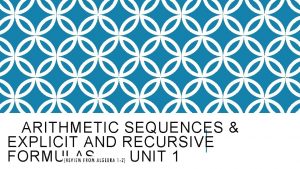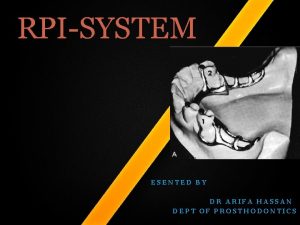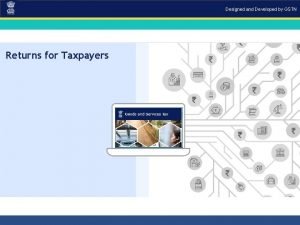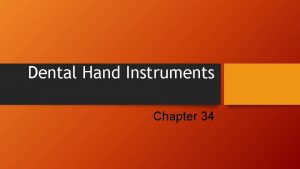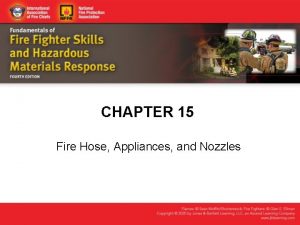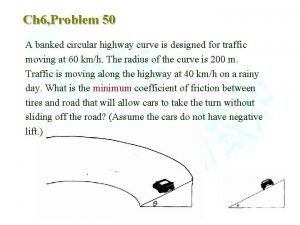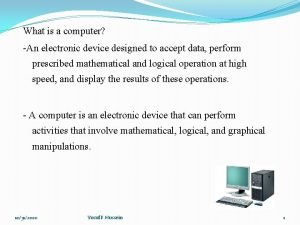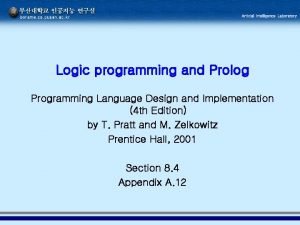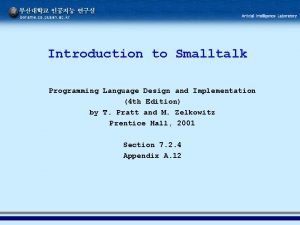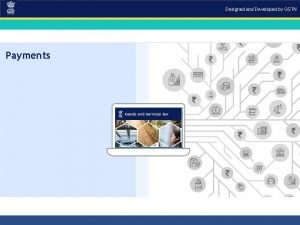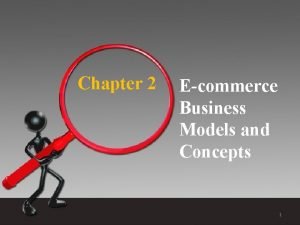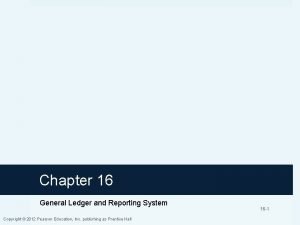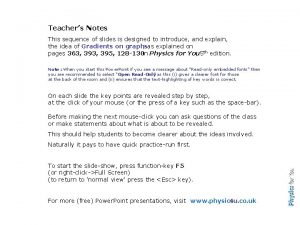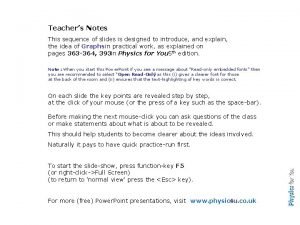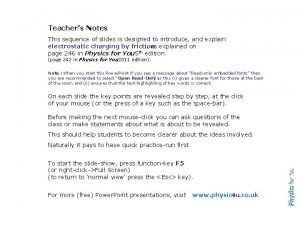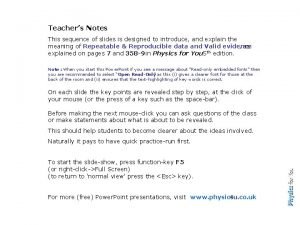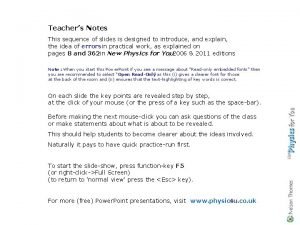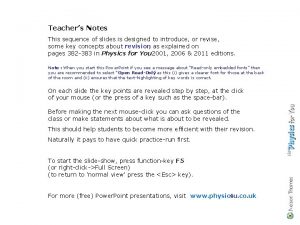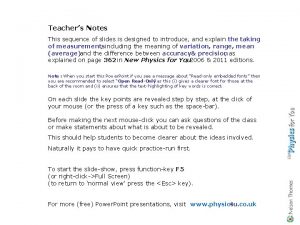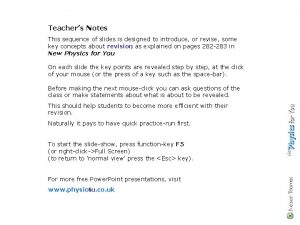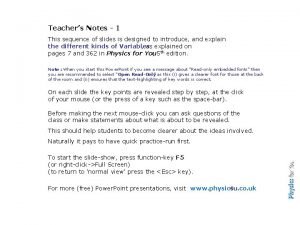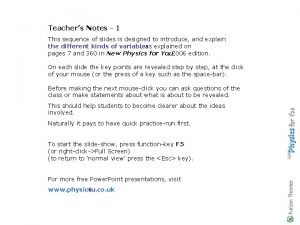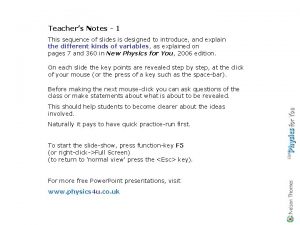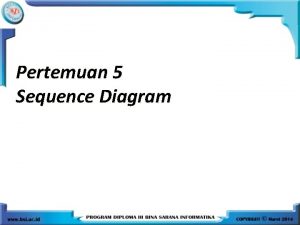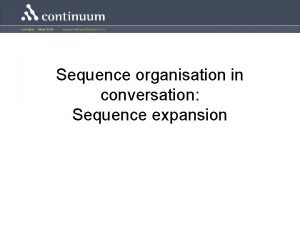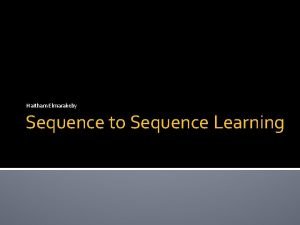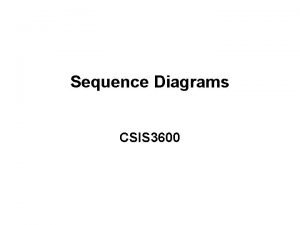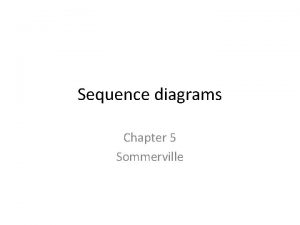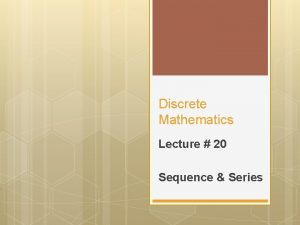Teachers Notes This sequence of slides is designed































- Slides: 31

Teacher’s Notes This sequence of slides is designed to introduce, and explain, the idea of errors (uncertainties) in practical work, as explained on pages 8 and 360 -361 in Physics for You , 5 th edition. Note : When you start this Power. Point if you see a message about “Read-only embedded fonts” then you are recommended to select “Open Read-Only ” as this (i) gives a clearer font for those at the back of the room and (ii) ensures that the text-highlighting of key words is correct. On each slide the key points are revealed step by step, at the click of your mouse (or the press of a key such as the space-bar). Before making the next mouse-click you can ask questions of the class or make statements about what is about to be revealed. This should help students to become clearer about the ideas involved. Naturally it pays to have quick practice-run first. To start the slide-show, press function-key F 5 (or right-click->Full Screen) (to return to ‘normal view’ press the <Esc> key). For more (free) Power. Point presentations, visit www. physics 4 u. co. uk

Working Scientifically: Errors (uncertainties) Physics for You, 5 th edition, pages 8 and 360

Learning Objectives You should learn : • About different types of errors, also called uncertainties, • How to reduce them when you are doing your practical work.

What is an error? An…causing error the resultinis is…so a mistake an uncertainty not results… accurate. of your some kind. . .

What is an error? Some are due to human error… For example, by not using the equipment correctly Let’s look at some examples.

Human error Example 1 Professor Messer is trying to measure the length of a piece of wood: Discuss what he is doing wrong. How many mistakes can you find? Six? Seven?

Human error Answers: 1. Measuring from 100 end 2. 95. 4 is the wrong number 3. ‘mm’ is wrong unit (cm) 4. Hand-held object, wobbling 5. Gap between object & the rule 6. End of object not at the end of the rule 7. Eye is not at the end of the object (parallax) 8. He is on wrong side of the rule to see scale. How many did you find?

Human error Example 2 Reading a scale: Discuss the best position to put your eye

Human error 2 is best. 1 and 3 give the wrong readings. This is called a parallax error. It is due to the gap here, between the pointer and the scale. Should the gap be wide or narrow? your eye

Anomalous results When you are doing your practical work, you may get an odd or inconsistent or ‘anomalous’ reading. This may be due to a simple mistake in reading a scale. The best way to identify an anomalous result is to draw a graph. For example. . .

Anomalous results Look at this graph: Which result do you think may be anomalous? x x x A result like this should be taken again, to check it.

Types of errors When reading scales, there are 2 main types of error: • Random errors • Systematic errors. Let’s look at some examples. . .

Random errors These may be due to human error, a faulty technique, or faulty equipment. When timing a pendulum you may start the stopwatch too soon, or too late, randomly.

Random errors To reduce the error, take a lot of readings, and then calculate the average (mean). For example, suppose the 6 results from timing 20 swings of a pendulum are: 21. 7 s 21. 5 s 22. 1 s 21. 5 s 21. 6 s 21. 8 s We can get a more accurate value by calculating the mean (average), like this: Time for 20 swings = 21. 7 + 21. 5 + 22. 1 + 21. 5 + 21. 6 + 21. 8 = 6 21. 7 s

Random errors : Uncertainty But this value will have an uncertainty in it. How can we estimate this uncertainty? Using the same 6 results for the pendulum but ordering them from low to high: 21. 5 s 21. 6 s 21. 7 s 21. 8 s 22. 1 s So the Range is 22. 1 – 21. 5 = 0. 6 s Because the results are randomly about half above and half below the mean, then the uncertainty is half the range = 0. 3 s So we can say the time for 20 swings is 21. 7 ± 0. 3 s (ie. the true value will probably be between 21. 4 and 22. 0 seconds. )

Systematic errors These errors cause readings to be shifted one way (or the other) from the true reading. Your results will be systematically wrong. Let’s look at some examples. . .

Systematic errors Example 1 Suppose you are measuring with a ruler: If the ruler is wrongly calibrated, or if it expands, then all the readings will be too low (or all too high):

Systematic errors Example 2 If you have a parallax error: with your eye always too high then you will get a systematic error All your readings will be too high.

Systematic errors A particular type of systematic error is called a zero error. Here are some examples. . .

Zero errors Example 3 A spring balance: Over a period of time, the spring may weaken, and so the pointer does not point to zero: What effect does this have on all the readings?

Zero errors Example 4 Look at this top-pan balance: It has a zero error. There is nothing on it, but it is not reading zero. What effect do you think this will have on all the readings?

Zero errors Example 5 Look at this ammeter: If you used it like this, what effect would it have on your results?

Zero errors Example 6 Look at this voltmeter: What is the first thing to do? Use a screwdriver here to adjust the pointer.

Zero errors Example 7 Look at this ammeter: What can you say? Is it a zero error? Or is it parallax?

Zero error, Parallax error Example 8 Look at this ammeter: It has a mirror behind the pointer, near the scale. What is it for? When theyou image pointer in theerror? mirror How can useofit the to stop parallax is hidden by the pointer itself, then you are looking at 90 o, with no parallax.

In summary • Human errors can be due to faulty technique. • Parallax errors can be avoided. • Anomalous results can be seen on a graph. • Random errors can be reduced by taking many readings, and then calculating the average (mean). The uncertainty is half the range. • Systematic errors, including zero errors, will cause all your results to be wrong.

Learning Outcomes You should now: • Understand the effects of - Human error, including parallax error, - Random errors, including how to calculate the uncertainty - Systematic errors, including zero errors • Be able to reduce these errors when doing your practical work • Be able to identify anomalous results.

For more details, see: Ø Physics for You, 5 th edition, pages 8, 360 For more free Power. Points, visit Ø the web-site at www. physics 4 u. co. uk

If you are connected to the web at the moment, click below to see what’s available: http: //www. physics 4 u. co. uk/


 Kim kroll teachers pay teachers
Kim kroll teachers pay teachers A small child slides down the four frictionless slides
A small child slides down the four frictionless slides A crane lowers a girder into place
A crane lowers a girder into place Nucleotides of rna
Nucleotides of rna What is a pseudocode with example?
What is a pseudocode with example? Sum of a finite arithmetic series
Sum of a finite arithmetic series Convolutional sequence to sequence learning.
Convolutional sequence to sequence learning. Site:slidetodoc.com
Site:slidetodoc.com Cube wisc
Cube wisc The shaft are design on the basis of
The shaft are design on the basis of Specially designed instruction chart
Specially designed instruction chart Gingival approach clasp
Gingival approach clasp Every system is designed to get the results it gets
Every system is designed to get the results it gets Baldwin family health care
Baldwin family health care A program designed to send you advertisements
A program designed to send you advertisements Designed & developed by gstn
Designed & developed by gstn The three specific parts of hand instruments are the
The three specific parts of hand instruments are the Distributive strategy
Distributive strategy An internet is a collection of utility programs designed
An internet is a collection of utility programs designed Which type of valve is typically used on engine discharges?
Which type of valve is typically used on engine discharges? A banked circular highway curve is designed
A banked circular highway curve is designed Artificial intelligence devices
Artificial intelligence devices Condition for uniform wear theory
Condition for uniform wear theory Prolog basic programs
Prolog basic programs Small talk programming language examples
Small talk programming language examples Designed & developed by gstn
Designed & developed by gstn Lift slab operations must be designed and planned by
Lift slab operations must be designed and planned by A is the set of planned activities designed to result
A is the set of planned activities designed to result General ledger
General ledger What is a machine designed to do
What is a machine designed to do Characteristics of a well designed experiment
Characteristics of a well designed experiment Alfred binet designed the first ______ test.
Alfred binet designed the first ______ test.







